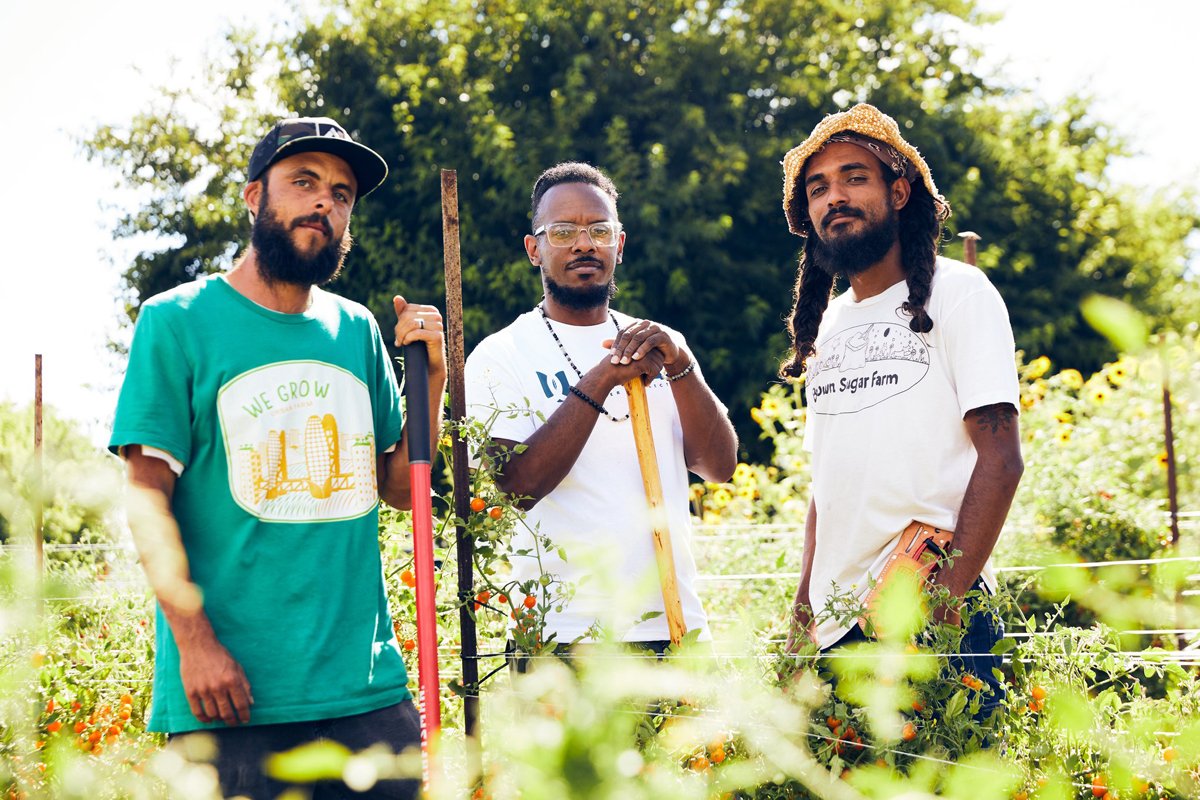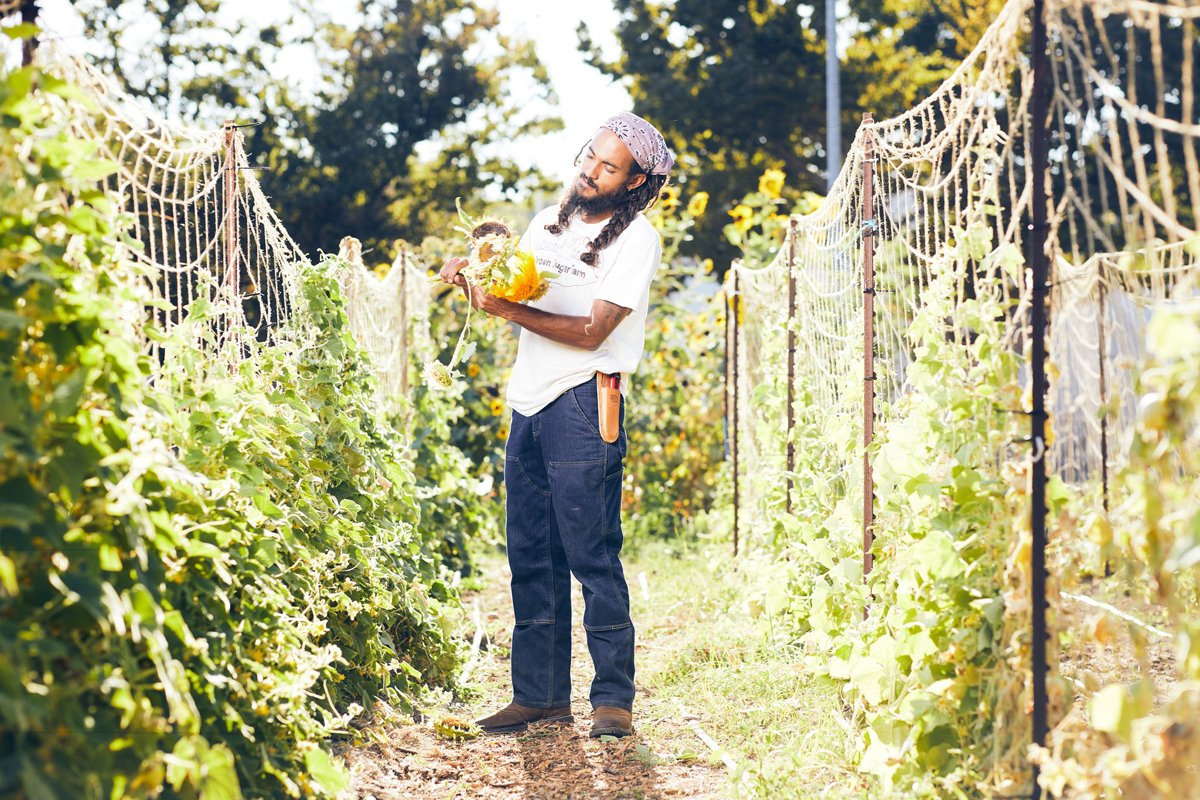With a recent grant from the state of California, Ujamaa Farmer Collective hopes to provide farmers of color with land to start or grow farming businesses.

With a recent grant from the state of California, Ujamaa Farmer Collective hopes to provide farmers of color with land to start or grow farming businesses.
October 24, 2023

Ujamaa Farm Collective was founded by Nelson Hawkins (left), Keith Hudson (center), and Nathaniel Brown (right). (Photo credit: Jason Elias Photography)
Surrounded by low-income apartments, senior housing, and the cheerful hum of an elementary school playground, We Grow Farms is an unlikely yet central landmark in West Sacramento. Just a few miles from California’s state capital, owner Nelson Hawkins has turned an abandoned half-acre lot into a hub of food production for the community. Leased through the West Sacramento Urban Farm Program, the regenerative urban oasis attracts nearby residents, students, and plenty of honeybees.
After six years of enriching the soil and cultivating neighborly relationships, however, We Grow Farms is up against an insurmountable challenge facing many farms and pastures across the state: the real estate market. In the next year, the lot’s landowner, a developer, plans to turn the urban farm into affordable housing to feed an acute regional housing demand.
While Hawkins is sympathetic to the need, he says the farm’s uprooting will come at a great cost. He estimates that he has invested nearly $40,000 in soil improvements and irrigation infrastructure alone, and the loss will also impact the underserved communities We Grow supports.
As a Black farmer, Hawkins also provides a visible, powerful connection between food and its source, supplying the neighborhood with fresh produce such as collard greens, black-eyed peas, and tomatillos at its weekly, onsite farm stand. The rest is distributed to nearby urban and suburban areas in Yolo and Sacramento counties through food programs and community supported agriculture (CSA) subscription boxes—25 percent of it for free.
Small-scale farms are highly sensitive to the profession’s many challenges, including extreme weather, rising water and labor costs, and razor-thin margins. And for the majority that rent or lease their fields, the lack of long-term land stability can make farming “a David and Goliath battle,” Hawkins says—especially for growers who are Black, Indigenous, and people of color (BIPOC). Together, BIPOC growers own less than 2 percent of all farmland in the country.
But Hawkins, along with Nathaniel Brown and Keith Hudson—two other Black growers in the Sacramento River Delta—have a plan to address the disparity. As founders of the nonprofit Ujamaa Farmer Collective, the trio aim to strengthen the roots for historically underserved farmers by staking a cooperative claim to land ownership.
“You need at least $1 million to purchase farmland in California, and that doesn’t even include the tools, infrastructure, resources, and the labor.”
After persistent advocacy efforts by agriculture groups, the California legislature allotted a $1.25 million grant in 2022 to Ujamaa for the purchase of a medium-sized plot of land in Yolo County. The deed secures the tenure for multiple farms to operate on individual plots ranging in size from half an acre to 5 acres, each with a voice in collective governance and access to shared resources.
By building a resilient, worker-controlled network on secure soil, Ujamaa—which is named after a Swahili word for extended family and the fourth principle of Kwanzaa, embodying cooperative economics and advancement—will “elevate everybody’s potential so [we] can all thrive,” says Hawkins.
Agriculture-based collectives, such as farmer cooperatives and produce and commodity associations, are well-established in this country. Yet “they’re often white-led and they’ve had privilege,” including greater access to land and resources, says Brandi Mack, national director of The Butterfly Movement, an educational organization working to connect BIPOC women to the land through permaculture.
Mack is also a member of the People’s Land Fund, a collaborative that includes members from seven other social justice and agriculture nonprofits and is providing Ujamaa with pilot support, including pre-development guidance and starting capital.
Ujamaa’s purpose “is a different consciousness,” Mack says. Collective land ownership and governance set the course for “redistributing the flow to BIPOC farmers,” empowering them to build a more resilient community by amplifying their voices and “getting a leg up in the food sovereignty game.”
California’s recent initiative is part of a larger state commitment that started in 2017 with the Farmer Equity Act, which aims to increase resource equity among historically underserved farmers. Other endeavors have included a $40 million allocation to Allensworth, the state’s first Black community founded in 1908, to invest in an organic farm and other enhancement, preservation, and planning projects, as well as land restoration for tribal communities.
“We’re trying to get away from the more colonial, extractive, and destructive systems that have shaped farming over the last 100 years.”
The efforts come at a crucial point for Black farmers, whose numbers have been on a precarious national decline over the last century. At their peak in 1910, African Americans made up around 14 percent of all U.S. growers and owned more than 16 million acres of land. Today, they make up just 1.3 percent of all farmers and own fewer than 5 million acres. The Golden State’s numbers are even more dire; the 2017 U.S. Department of Agriculture (USDA) census counted just 429 African Americans out of approximately 124,000 producers.
Meanwhile, national efforts to reverse disparities continue to fall short. Facing fierce political backlash, the 2021 American Rescue Plan Act—a debt relief program intended as restitution for decades of documented discrimination against Black and Indigenous farmers by the USDA— was rewritten to remove race from eligibility requirements. And recent reports also uncovered disproportionately high USDA loan rejection rates for BIPOC growers under the Trump administration.
For historically underserved farmers, land security is fundamental to leveling the field, says Jamie Fanous, policy director at the Community Alliance with Family Farmers, a nonprofit that advocated for Ujamaa’s legislative allocation. Yet intense competition for land in the state has widened the gap in farm ownership, she adds. Currently, more than half of the state’s cropland is held by 5 percent of landowners, while one-third of all fields and pastures are rented or leased out by non-farming landowners.
“Land grabs are rampant” throughout California, says Fanous, noting the latest case in which an investment group snatched up 55,000 acres of ranch and farmland in Solano County, in the northeastern San Francisco Bay Area. “And it’s getting worse as we see hedge funds and corporations come in,” she says.
Investors usually amass agricultural parcels for planting large-scale, high-value commodity crops, or develop them for residential and urban uses. As bigger players take over the landscape, it’s typically at the expense of smaller ones, and a disproportionate number of those tend to be BIPOC and historically underserved farmers.
“You need at least $1 million to purchase farmland in California, and that doesn’t even include the tools, infrastructure, resources, and the labor,” Fanous says. “It’s just insane, but that’s the reality we’re in right now.”
Brown, Ujamaa’s co-founder, has witnessed a drastic change in the Sacramento area. The owner of Brown Sugar Farm cultivates a half-acre parcel behind his family home in Citrus Heights, a residential neighborhood 15 miles northeast of West Sacramento. In less than two decades, he has seen much of the agricultural land nearby disappear, including a pumpkin patch and a barnyard once located across the street.
The 29-year-old grower has carved a successful niche at local farmers markets selling unconventional crops such as Caribbean red, striped, and fish peppers, stinging nettles, and flowers, all grown using a home-brewed, brown sugar-based fertilizer. However, his farm, which includes two pygmy goats that help maintain weeds, is quickly outgrowing its space, Brown says. And despite the security of family property, there’s no room to expand.
Along with more fields and new water infrastructure, Brown’s wish list of upgrades includes cold storage, a washing and staging station, and tractor access—most of which require additional space, construction, and expensive permits. Without the ability to scale up, these investments simply won’t pan out, he says.

Nathanial Brown owns Brown Sugar Farms in Citrus Heights, where he grows unusual crops such as Caribbean red, striped, and fish peppers, stinging nettles, and flowers. He uses a home-brewed, brown sugar-based fertilizer instead of commercial fertilizer. (Photo credit: Jason Elias Photography)
For small-scale farmers, particularly those engaged in regenerative practices, the return on investment in soil health, irrigation, and crops can often take years to realize. Farming, though, “is a long-term process,” says Brown, as is stewarding the earth, so moving his operations to Ujamaa’s new land will allow him to “think a few seasons ahead.”
The stability of land ownership lets farmers plan more resilient and diverse operations, he adds. Orchards and other perennials, for example, make more sense when you own your own land because they can take a while to mature. And while permanent crops don’t typically yield immediate profits, they can help buffer producers from pests, disease, and market spikes. Building up healthy soil can also increase carbon sequestration and moisture retention, reducing the impacts of drought, extreme rainfall, and the increasing challenges from climate change.
As a collective, “we’re trying to get away from the more colonial, extractive, and destructive systems that have shaped farming over the last 100 years,” Brown says.
The stability of the collective also reinforces a culturally relevant model of land and community stewardship. “Intentional community started with Black folks in this country,” says Mack, of the People’s Land Fund. She notes that rural livelihoods, marginalization, and meager economic resources—the reality of Black roots in this country— have encouraged strong cooperative networks. “That’s the only way we survived.”
Still, “it’s difficult to unbuild how land was used to punish us for 400 years,” Mack says, referring to the deep scars left by a history of enslavement and sharecropping. She sees greater representation in the field as key to reclaiming that relationship for a new generation. “With the land stewards themselves being folks of color and running the program,” she adds, Ujamaa “is really going to help shift the paradigm.”
Ujamaa’s Hawkins also sees the collective cultivating much more than food. The organization’s mission is to fill the gap for historically underserved growers who lack access to land, generational wealth, or a family background in farming, he says. The individual farms that compose the collective will tap into shared resources such as water, infrastructure, and large equipment, while nurturing and sharing skills and institutional knowledge about regenerative practices and long-term land stewardship. Ujamaa will also make onsite worker housing a key priority.
“There’s security in a collective,” says Hawkins, noting that he sees Ujamaa as both a scalable and replicable model of collective ownership and governance. “The more we can work together, nudge each other, and educate each other—we’re stronger together.”
Minnow, a member of the People’s Land Fund and a nonprofit organization advancing social equity in farming, is currently helping Ujamaa develop its collective governance structure.
Hawkins, Brown, and Hudson also hope to create a safe space for the BIPOC community, which, Hawkins notes, is often a rarity in rural areas. He hopes the Yolo County location will keep Ujamaa farmers connected to urban markets, community resources, and organizations.
“We want to maintain those relationships,” he says, “and expand our impact to folks that need better access to fresh food.”
“Growing food brings people together in such a powerful way,” says Hawkins, who hopes that the land acquisition will materialize by the end of the year. But with a huge systemic imbalance for those who produce it, “now’s the time for us to make that shift happen in a racially equitable way,” he adds. “Otherwise, it’s just going to be the same thing.”

October 9, 2024
In this week’s Field Report, MAHA lands on Capitol Hill, climate-friendly farm funding, and more.
October 2, 2024

October 2, 2024

October 1, 2024

September 30, 2024

September 25, 2024

September 25, 2024

Like the story?
Join the conversation.